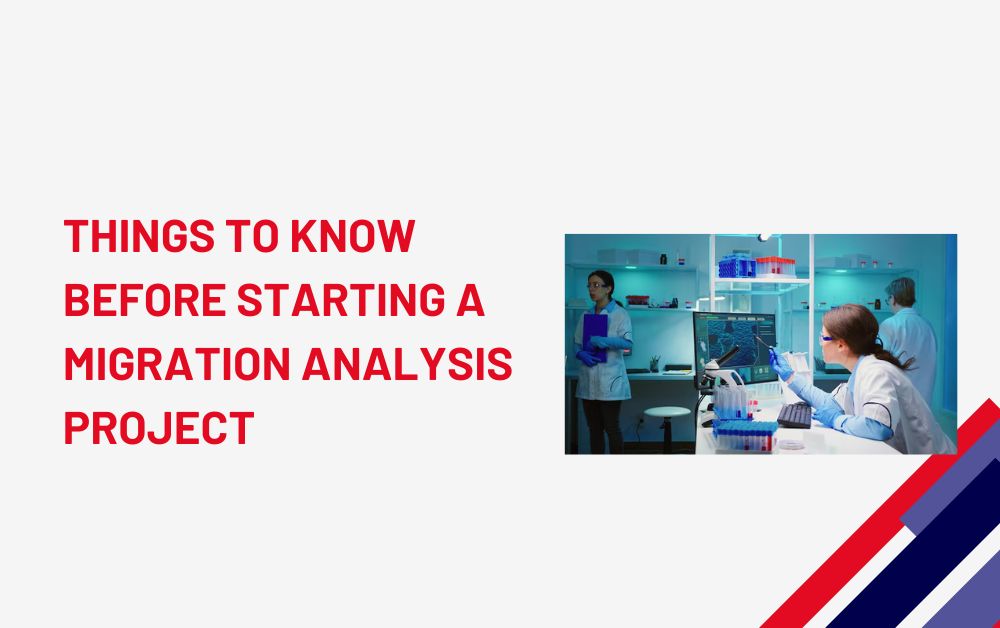Starting a migration analysis project is a critical step for any business looking to upgrade or transition its systems, whether it’s moving to a new software platform, migrating to the cloud, or updating infrastructure. Proper planning and analysis can make the difference between a smooth transition and a disruptive, costly experience. This blog will guide you through the essential things you need to know before embarking on a Migration analysis project, using simple language and a friendly tone to ensure everyone can understand.
Basics of Migration Analysis
What is Migration Analysis?
Migration analysis is the process of evaluating the current system environment and planning the steps needed to move data, applications, or entire systems to a new environment. It involves assessing technical requirements, potential risks, and the overall impact on business operations.
Why is Migration Analysis Important?
A thorough migration analysis helps to prevent issues such as data loss, extended downtime, and compatibility problems. It ensures that the migration process is efficient, cost-effective, and minimally disruptive to the business.
Key Steps in a Migration Analysis Project
Step 1: Define Objectives and Scope
Clarifying Goals
Start by defining what you aim to achieve with the migration. Are you looking to improve performance, reduce costs, enhance security, or support new business processes? Clear objectives will guide the entire project.
Determining the Scope
Outline the scope of the migration. This includes specifying what data, applications, and systems will be moved. A well-defined scope helps in setting realistic expectations and planning resources effectively.
Step 2: Assess the Current Environment
Conducting an Inventory
Create a detailed inventory of all assets involved in the migration. This includes hardware, software, data, and any dependencies. Knowing what you have will help in planning the migration accurately.
Evaluating System Performance
Assess the current performance of your systems. Identify any issues or bottlenecks that need to be addressed during the migration. This step ensures that you do not carry over existing problems to the new environment.
Step 3: Analyze the Target Environment
Understanding the New Environment
Evaluate the capabilities and limitations of the target environment. Whether it’s a new data center, cloud platform, or software, understanding how it operates is crucial for a smooth transition.
Compatibility Checks
Ensure that the new environment supports all your current applications and data formats. Compatibility checks help to avoid surprises and ensure that everything works seamlessly post-migration.
Step 4: Identify Risks and Challenges
Risk Assessment
Identify potential risks associated with the migration. This could include data loss, security breaches, or system incompatibilities. A thorough risk assessment allows you to develop strategies to mitigate these risks.
Developing Contingency Plans
Prepare contingency plans to address potential issues that could disrupt the migration. This includes having backups, alternative migration paths, and additional resources ready to address problems as they arise.
Step 5: Plan the Migration Strategy
Choosing the Migration Method
Decide on the best migration method for your needs. Common methods include a “big bang” migration, where everything is moved at once, or a phased migration, where data and applications are moved in stages.
Creating a Detailed Plan
Develop a comprehensive migration plan that includes timelines, resource allocation, and specific tasks for each phase of the migration. This plan will serve as a roadmap for the entire process.
Step 6: Test the Migration Process
Pre-Migration Testing
Before executing the full migration, conduct tests to ensure that the process works as planned. This might involve moving a small subset of data or running simulations to identify potential issues.
Validating Results
After testing, validate the results to ensure that the data and applications function correctly in the new environment. This helps to identify and address any issues before the full migration.
Step 7: Execute the Migration
Performing the Migration
With the plan in place and testing completed, execute the migration according to the outlined strategy. Ensure that all team members are aware of their roles and responsibilities during this phase.
Monitoring the Process
Monitor the migration process closely to ensure that everything is proceeding as planned. Be prepared to address any issues that arise promptly to minimize disruption.
Step 8: Post-Migration Validation and Support
Verifying the Migration
After the migration is complete, conduct a thorough verification to ensure that all data and applications are functioning correctly in the new environment. Check for any discrepancies or issues that need to be resolved.
Providing Ongoing Support
Provide ongoing support to address any post-migration issues. This might involve troubleshooting problems, optimizing the new environment, or providing training to users.
Tips for a Successful Migration Analysis Project

Engage Stakeholders Early
Involve key stakeholders from the beginning to ensure that their needs and concerns are addressed. This helps to secure buy-in and ensures that the migration aligns with business goals.
Use Experienced Personnel
Ensure that your team includes individuals with experience in migration projects. Their expertise can help to navigate complex issues and ensure a smooth transition.
Document Everything
Keep detailed records of all aspects of the migration analysis and execution. Documentation helps in tracking progress, identifying issues, and providing a reference for future projects.
Communicate Clearly
Maintain clear and consistent communication throughout the project. Regular updates and open lines of communication help to manage expectations and address any concerns promptly.
Conclusion
Starting a migration analysis project requires careful planning and thorough assessment to ensure a successful transition. By defining clear objectives, assessing both the current and target environments, identifying risks, and planning meticulously, you can minimize disruptions and ensure a smooth migration. Following these steps and tips will help you to navigate the complexities of migration and achieve a seamless transition that supports your business goals and enhances overall system performance.
Note:-For more articles visit on articlestores.
